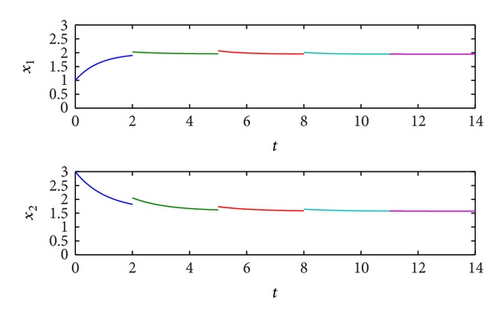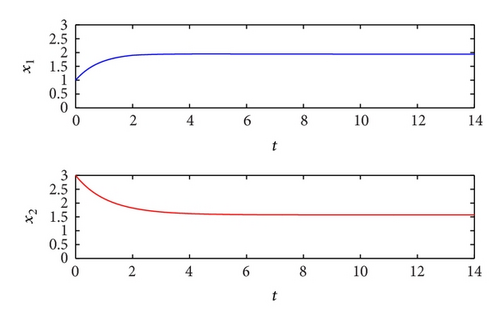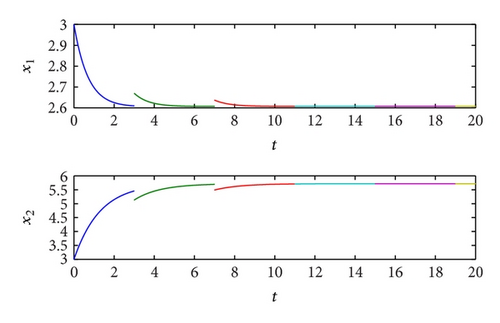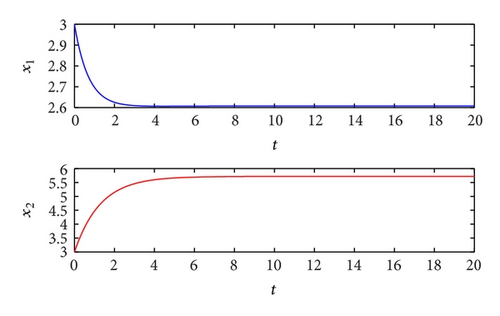Existence and Global Exponential Stability of Equilibrium for Impulsive Cellular Neural Network Models with Piecewise Alternately Advanced and Retarded Argument
Abstract
We introduce impulsive cellular neural network models with piecewise alternately advanced and retarded argument (in short IDEPCA). The model with the advanced argument is system with strong anticipation. Some sufficient conditions are established for the existence and global exponential stability of a unique equilibrium. The approaches are based on employing Banach’s fixed point theorem and a new IDEPCA integral inequality of Gronwall type. The criteria given are easily verifiable, possess many adjustable parameters, and depend on impulses and piecewise constant argument deviations, which provides exibility for the design and analysis of cellular neural network models. Several numerical examples and simulations are also given to show the feasibility and effectiveness of our results.
1. Introduction
Chua and Yang [1] proposed a novel class of information-processing systems called cellular neural networks (CNNs) in 1988. Like neural networks, it is a large-scale nonlinear analog circuit which processes signals in real time. Like cellular automata [2] it is made of a massive aggregate of regularly spaced circuit clones, called cells, which communicate with each other directly only through its nearest neighbors. Each cell is made of a linear capacitor, a nonlinear voltage-controlled current source, and a few resistive linear circuit elements. The key features of neural networks are asynchronous parallel processing and global interaction of network elements. Impressive applications of neural networks have been proposed for various fields such as optimization, linear and nonlinear programming, associative memory, pattern recognition, and computer vision. For the circuit diagram and connection pattern implementing the CNN, one can refer to [1]. The CNN can be applied in signal processing and can also be used to solve some image processing and pattern recognition problems [3]. However, it is necessary to solve some dynamic image processing and pattern recognition problems by using delayed cellular neural networks (DCNN) [4–6]. The study of the stability of CNN and DCNN is known to be an important problem in theory and applications.
On the other hand, in real world, many evolutionary processes are characterized by abrupt changes at certain time. These changes are known to be impulsive phenomena, which are included in many fields such as physics, chemistry, population dynamics, and optimal control. Fundamental theory of impulsive differential equations has been developed in [7]. Furthermore, researches of impulsive differential equations have been received much interesting in recent years [8–18]. Meanwhile, several kinds of neural networks with impulse have been investigated. In particular, Xu and Yang established the delay differential inequalities with impulsive initial conditions; some new sufficient conditions for global exponential stability of impulsive delay model were obtained [15, 16].
Most neural networks can be classified into two types, continuous or discrete. However, many real-world systems and natural processes cannot be categorized into one of them. They display characteristics both continuous and discrete styles. For instance, some biological neural networks in biology, bursting rhythm models in pathology, and optimal control models in economics are characterized by abrupt changes of state. These are the familiar impulsive phenomena.
It is well known that applications of CNN depend crucially on the dynamical behavior of the networks. In these applications, stability and convergence of neural networks are prerequisites. However, in the design of neural networks one is interested not only in the uniform asymptotic stability but also in the global exponential stability, which guarantees a neural network to converge fast enough in order to achieve fast response. In addition, in the analysis of dynamical neural networks for parallel computation and optimization, to increase the rate of convergence to the equilibrium point of the networks and reduce the neural computing time, it is necessary to ensure a desired exponential convergence rate of the networks′ trajectories, starting from arbitrary initial states to the equilibrium point which corresponds to the optimal solution. Thus, from the mathematical and engineering points of view, it is required that the neural networks have a unique equilibrium point which is globally exponentially stable. Therefore, the problem of stability analysis has received great attention and many results on this topic have been reported in the literature. See, for instance, [4, 9, 13, 19–27] and references cited therein.
1.1. Piecewise Constant Impulsive Systems
Impulsive differential equations with discontinuous argument are proposed as an open problem by Wiener [30] in 1994, namely, the impulsive differential equations with piecewise constant argument: IDEPCA. As we know, impulsive differential equations with piecewise constant arguments (in short IDEPCA) are studied in a few papers [8, 39, 40].
1.2. Model Description
Let us clarify why the IDEPCA (4a)-(4b) is of alternately advanced and retarded type; that is, the argument can change its deviation character during the motion. The argument is deviated if it is advanced or retarded. Fix k ∈ ℕ, and consider the IDEPCA on the interval Ik = [mk − l, m(k + 1) − l). Then, the identification function m[(t + l)/m] is equal to mk. If , then m[(t + l)/m] ≥ t and IDEPCA (4a)-(4b) is an equation with advanced argument. Similarly, if then m[(t + l)/m] < t and IDEPCA (4a)-(4b) is an equation with retarded argument. Consequently, IDEPCA (4a)-(4b) changes the type of deviation of the argument during the process. In other words, the IDEPCA (4a)-(4b) is of alternately advanced and retarded type.
2. Existence and Uniqueness Theorems
In this section, sufficient conditions that govern the network parameters and the activation functions are established for the existence of a unique equilibrium state of the impulsive cellular neural network models (5a)-(5b).
2.1. Preliminaries and Definition
In this section, we will focus our attention on some preliminary results which will be used in the existence and uniqueness of solutions of the ICNNs with IDEPCA system (5a)-(5b).
For every t ∈ ℝ, let i = i(t) ∈ ℕ be the unique integer such that t ∈ Ii = [mi − l, m(i + 1) − l).
For the sake of convenience, two of the standing assumptions are formulated below.
- (L)
The activation functions fj and gj with fj(0) = 0, gj(0) = 0 (j = 1,2, …, n) satisfy the Lipschitz condition; that is, there are constants , such that
()for all u, v ∈ ℝ+.
- (E)
Consider
()where .
First, we prove the existence and uniqueness of solutions of IDEPCA system (5a)-(5b). A natural extension of the original definition of a solution of DEPCA [28–30, 42] allows us to define a solution of IDEPCA system.
Definition 1. A function x is a solution of IDEPCA system (5a)-(5b) in ℝ+ = [0, ∞) if
- (i)
x(t) is continuous for t ∈ ℝ+ with the possible exception of the points t = mk − l, k ∈ ℕ,
- (ii)
x(t) is right continuous and has left-hand limits at the points t = mk − l, k ∈ ℕ,
- (iii)
x(t) is differentiable and satisfies (5a) for any t ∈ ℝ+, with the possible exception of the points t = mk − l, k ∈ ℕ, where one-sided derivatives exist,
- (iv)
x(n) satisfies (5b) for n = km − l, k ∈ ℕ.
To study nonlinear IDEPCA system, we will use the approach based on the construction of an equivalent integral equation. Let us give the following proposition.
Proposition 2. Let (τ, x0) ∈ ℝ+ × ℝn. The function x(t) = x(t, τ, x0) is a solution on ℝ+ of the IDEPCA system (5a)-(5b) in the sense of Definition 1 if and only if it is a solution of the integral equation
The proof of Proposition 2 is almost identical to the verification in [7] with slight changes which are caused by the piecewise constant argument.
In the next, we give the following lemma about IDEPCA integral inequality of Gronwall type, which is one of the most important auxiliary results of the present paper.
Lemma 3. Let u : ℝ → [0, ∞) be a function such that u is continuous with possible points of discontinuity of the first kind at t = mk − l,k ∈ ℕ, and η1, η2 are nonnegative real constants satisfying
Proof. Call v(t) the right member of (16). So v(τ) = u(τ), u ≤ v, and v is a piecewise differentiable and nondecreasing function and, by (16), it satisfies
We need to have the global unique existence of solutions x(t) = x(t, τ, x0) on ℝ+ of the nonlinear IDEPCA system (5a)-(5b).
One can easily see that IDEPCA system (5a)-(5b) has the form of DEPCA system without impulsive effect within the intervals [mi − l, m(i + 1) − l),i ∈ ℕ; then using the same technique of [34, 35, 37] we have the following results.
Proposition 4. Suppose that conditions (L) and (E) hold. For any (τ, x0) ∈ ℝ+ × ℝn there exists a unique solution x(t) = x(t, τ, x0) of the IDEPCA system (5a)-(5b) on [mi(τ) − l, m(i(τ) + 1) − l).
Theorem 5. Under conditions (L) and (E), for every (τ, x0) ∈ ℝ+ × ℝn, there exists a unique solution x(t) = x(t, τ, x0) of the IDEPCA system (5a)-(5b) with x(τ) = x0 for t ∈ [τ, ∞) in the sense of Definition 1.
Proof. Fix τ ∈ ℝ+; then τ ∈ Ii(τ) = [mi(τ) − l, mi(τ) + m − l). Use Proposition 4 with x(τ) = x0 to obtain the unique solution x(t) = x(t, τ, x0) on Ii(τ). Then apply the impulse condition to evaluate uniquely
2.2. Existence and Uniqueness of Equilibrium
When impulsive cellular neural network models are used for the solution of optimization problems, one of the fundamental issues in the design of a network is concerned with the existence of a unique globally exponentially stable equilibrium state of network (5a)-(5b). Without requiring the boundedness, differentiability, or monotonicity, we establish easily verifiable sufficient conditions for the existence of a unique equilibrium state in this section.
In the following theorem, we obtain sufficient conditions for the existence of a unique equilibrium, , of the impulsive cellular neural network models (5a)-(5b).
Theorem 6. Suppose that conditions (L) and (E) hold and the neural parameters ai, bij, and cij and Lipschitz constants , satisfy
Proof. Let us consider a mapping G(u) = (G1(u), G2(u), …, Gn(u)) T ∈ ℝn, where u = (u1, u2, …, un) T ∈ ℝn and
3. Global Exponential Stability of Equilibrium
The existence and stability of a unique equilibrium state are usually a requirement in the design of cellular neural network models for various applications, particularly when there are destabilizing agents such as retarded arguments and impulses. However, even if the unique stable state exists, these agents may affect the convergence speed of the network, which in turn can downgrade the performance of the network in applications that demand fast computation in real-time mode. Thus, exponential stability is usually desirable for an impulsive network, and sufficient conditions for the global exponential stability of the unique equilibrium state x* of the ICNNs with IDEPCA system (5a)-(5b) are obtained in this section.
It is clear that the stability of the zero solution of (36) is equivalent to that of the equilibrium x* of the ICNNs with IDEPCA system (4a)-(4b). Therefore, we restrict our discussion to the stability of the zero solution of (36).
First of all, we give the following definition and lemma, which will be used in the proof of the stability of the zero solution for the ICNNs with IDEPCA system.
Definition 7. The equilibrium x* of the ICNNs with IDEPCA system (5a)-(5b) is said to be globally exponentially stable if there exist positive constants α and λ such that the estimation
Lemma 8. If (L) and (E) are satisfied, then the solutions φ and ψ of the IDEPCA system (5a)-(5b) satisfy for all t ≥ τ the inequality
Proof. Suppose that φ(t) = (φ1, …, φn) T and ψ(t) = (ψ1, …, ψn) T are arbitrary solutions of the IDEPCA system (5a)-(5b). Let y(t) = φ(t) − ψ(t) and by (5a) and (5b) it follows that y(·) satisfies
Hence, by Lemma 3 of IDEPCA Gronwall′s inequality implies
The following result will show sufficient conditions for the global exponential stability of the unique equilibrium of the ICNNs with IDEPCA system (5a)-(5b).
Theorem 9. If the assumptions of Theorem 6, (42) and
Proof. By Theorem 6, we know that the IDEPCA system (5a)-(5b) has a unique equilibrium x*. Let x(t, x0) be an arbitrary solution of (5a)-(5b) with initial condition x0 and define z(t) = x(t, x0) − x*. By Lemma 8 and (42), we obtain
Remark 10. To the best of the author′s knowledge, this is the first time we investigate impulsive cellular neural network models with piecewise alternately advanced and retarded argument in equilibrium case. Sufficient conditions are gained for the existence and exponential stability of a unique equilibrium of the ICNNs with IDEPCA system. And our results can be extended to a unique equilibrium of the CNNs with DEPCA system. See Corollaries 11–12. Our results about exponential stability of a unique equilibrium of the ICNNs with IDEPCA system may give some insight into the application of neural networks.
As immediate corollaries of Lemma 8 and Theorem 9, the following results without impulsive effects are true.
Corollary 11. If (L) and (E) are satisfied, then the solutions φ and ψ of the DEPCA system (5a) satisfy for all t ≥ τ the inequality
Corollary 12. If the assumptions of Corollary 11 and
Remark 13. In [41], authors investigated discrete-time cellular neural network without impulsive effects in almost periodic case. Simple sufficient conditions are gained for a unique almost periodic sequence solution which is globally attractive. When m = 1, l = 0, this conclusion of Corollary 12 cannot be derived by applying the corresponding stability result for cellular neural networks given in the literature [41] with ai, bij, cij, and di being constant coefficients.
4. Examples and Simulations
In this section, we give two examples with numerical simulations to illustrate the effectiveness of the proposed method and results.
Example 1. Consider the following impulsive cellular neural networks with piecewise alternately advanced and retarded argument:


Example 2. Consider the following impulsive cellular neural networks model with piecewise constant argument:
We can easily obtain that a* = 0.8, , , , , and .


5. Conclusions
This is the first time that impulsive differential equations with alternately advanced and retarded argument have been applied to the model of cellular neural network models, and this paper has provided sufficient conditions guaranteeing the existence, uniqueness, and global exponential stability of the unique equilibrium of the impulsive cellular neural network models for the considered system based on a new IDEPCA integral inequality of Gronwall type and fixed point theorem. In addition, our method gives new ideas not only from the modeling point of view but also from that of theoretical opportunities since the impulsive cellular neural network model equation involves piecewise constant arguments of both advanced and delayed types. The obtained results could be useful in the design and applications of impulsive cellular neural network models. Furthermore, the examples with numerical simulations are given to show the effectiveness of the proposed method and results.
Acknowledgments
The author thanks the referees and editor very much for their valuable suggestions which made this paper much improved. This research was in part supported by FIBE 01-12 DIUMCE.




